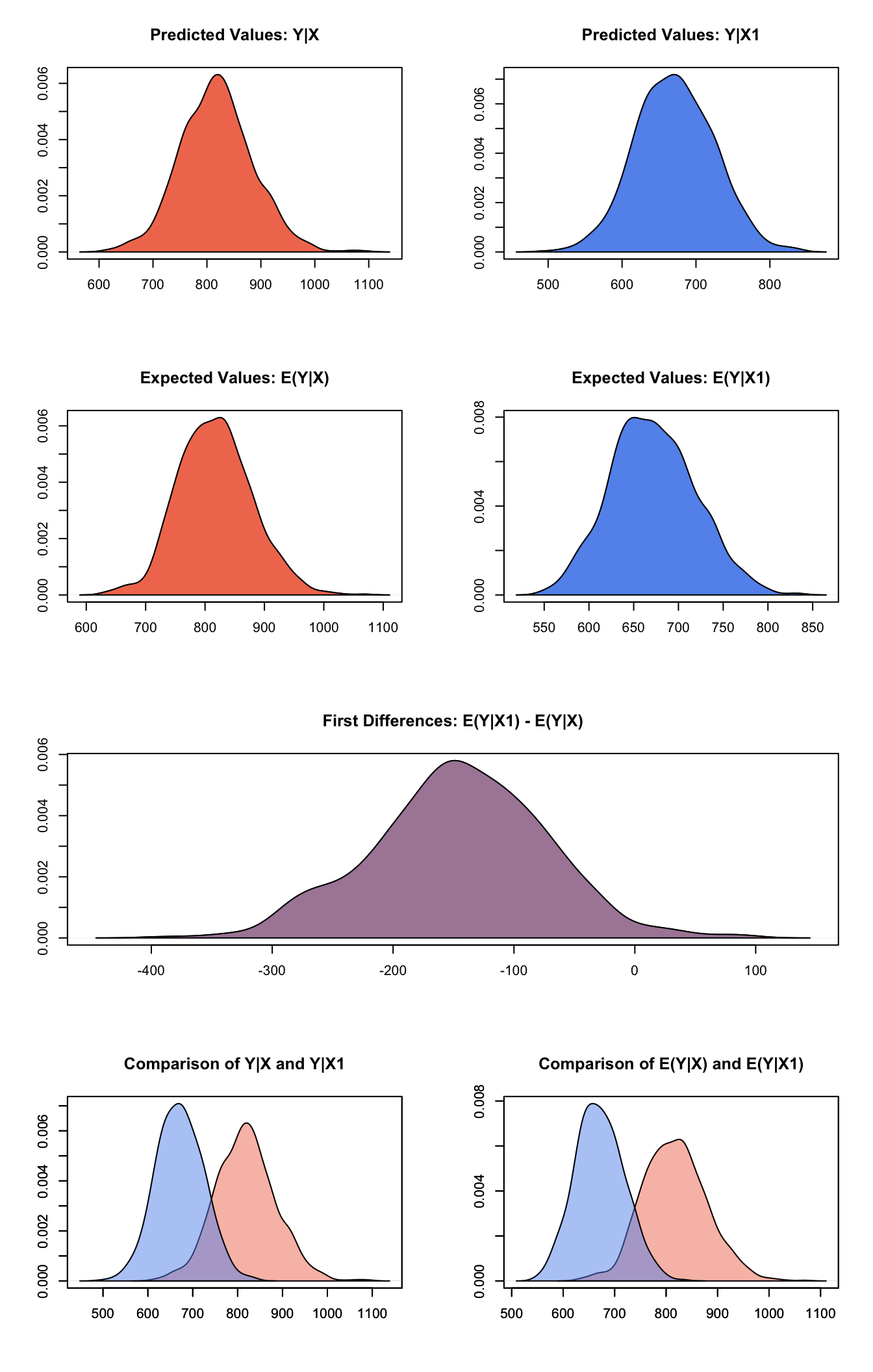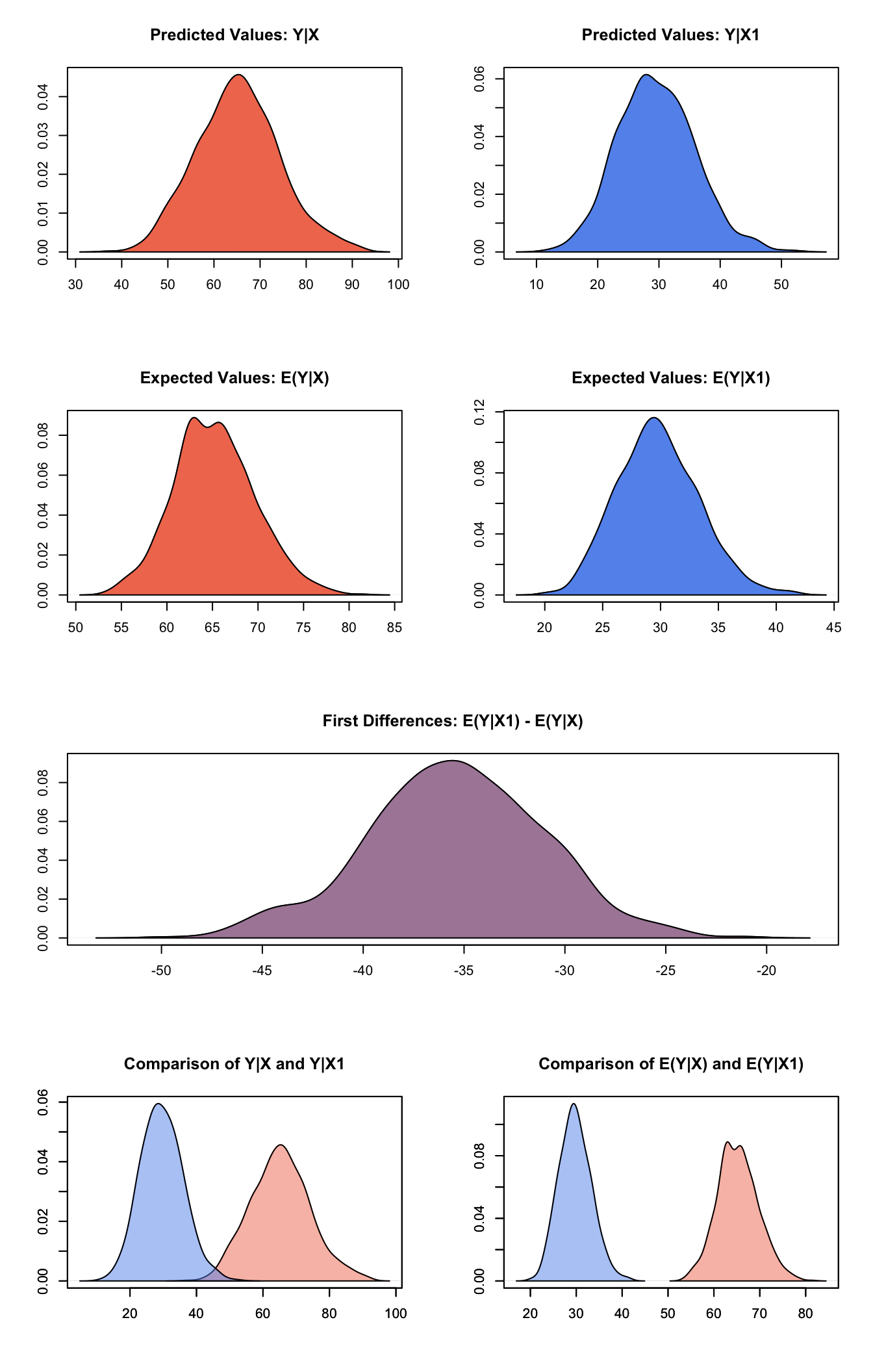Poisson Survey Regression
2017-10-29
Built using Zelig version 5.1.4.90000
Poisson Regression for Event Count Dependent Variables with Survey Weights with poisson.survey.
Use the Poisson regression model if the observations of your dependent variable represents the number of independent events that occur during a fixed period of time (see the negative binomial model for over-dispersed event counts.) For a Bayesian implementation of this model, see Zelig Poisson Bayes.
Example
Example 1: User has Existing Sample Weights
Attach sample data:
data(api, package="survey")In this example, we will estimate a model using each school’s academic performance in 2000 and an indicator for year-round schools to predict the number of students who enrolled in each California school.
z.out1 <- zelig(enroll ~ api99 + yr.rnd ,
model = "poisson.survey", data = apistrat)## Warning: Not all features are available in Zelig Survey.
## Consider using surveyglm and setx directly.
## For details see: <http://docs.zeligproject.org/articles/to_zelig.html>.## How to cite this model in Zelig:
## Nicholas Carnes. 2017.
## poisson-survey: Poisson Regression with Survey Weights
## in Christine Choirat, Christopher Gandrud, James Honaker, Kosuke Imai, Gary King, and Olivia Lau,
## "Zelig: Everyone's Statistical Software," http://zeligproject.org/summary(z.out1)## Model:
##
## Call:
## z5$zelig(formula = enroll ~ api99 + yr.rnd, data = apistrat)
##
## Survey design:
## survey::svydesign(data = data, ids = ids, probs = probs, strata = strata,
## fpc = fpc, nest = nest, check.strata = check.strata, weights = localWeights)
##
## Coefficients:
## Estimate Std. Error t value Pr(>|t|)
## (Intercept) 7.1282917 0.2645220 26.948 <2e-16
## api99 -0.0008395 0.0004091 -2.052 0.0415
## yr.rndYes 0.0556202 0.1730477 0.321 0.7482
##
## (Dispersion parameter for poisson family taken to be 391.138)
##
## Number of Fisher Scoring iterations: 5
##
## Next step: Use 'setx' methodSet explanatory variables to their default (mean/mode) values, and set a high (80th percentile) and low (20th percentile) value for the measure of academic performance, “api00”:
x.low <- setx(z.out1, api99= quantile(apistrat$api99, 0.2))
x.high <- setx(z.out1, api99= quantile(apistrat$api99, 0.8))Generate first differences for the effect of high versus low “meals” on the probability that a school will hold classes year round:
s.out1 <- sim(z.out1, x=x.low, x1=x.high)
summary(s.out1)##
## sim x :
## -----
## ev
## mean sd 50% 2.5% 97.5%
## [1,] 817.1636 61.73815 815.3758 704.7528 941.267
## pv
## mean sd 50% 2.5% 97.5%
## [1,] 818.18 67.05647 817 688.95 953.1
##
## sim x1 :
## -----
## ev
## mean sd 50% 2.5% 97.5%
## [1,] 671.6269 47.28784 670.2435 583.5333 769.5095
## pv
## mean sd 50% 2.5% 97.5%
## [1,] 671.552 53.03488 670.5 566.975 773.025
## fd
## mean sd 50% 2.5% 97.5%
## [1,] -145.5367 72.31272 -144.6802 -288.4826 -9.957065Generate a second set of fitted values and a plot:
plot(s.out1)
Graphs of Quantities of Interest for Poisson Survey Model
Example 2: User has Details about Complex Survey Design (but not sample weights)
Suppose that the survey house that provided the dataset excluded probability weights but made other details about the survey design available. We can still estimate a model without probability weights that takes instead variables that identify each the stratum and/or cluster from which each observation was selected and the size of the finite sample from which each observation was selected.
z.out2 <- zelig(enroll ~ api99 + yr.rnd ,
model = "poisson.survey", data = apistrat,
strata = ~stype, fpc = ~fpc)## Warning: Not all features are available in Zelig Survey.
## Consider using surveyglm and setx directly.
## For details see: <http://docs.zeligproject.org/articles/to_zelig.html>.## How to cite this model in Zelig:
## Nicholas Carnes. 2017.
## poisson-survey: Poisson Regression with Survey Weights
## in Christine Choirat, Christopher Gandrud, James Honaker, Kosuke Imai, Gary King, and Olivia Lau,
## "Zelig: Everyone's Statistical Software," http://zeligproject.org/summary(z.out2)## Model:
##
## Call:
## z5$zelig(formula = enroll ~ api99 + yr.rnd, data = apistrat,
## strata = ~stype, fpc = ~fpc)
##
## Survey design:
## survey::svydesign(data = data, ids = ids, probs = probs, strata = strata,
## fpc = fpc, nest = nest, check.strata = check.strata, weights = localWeights)
##
## Coefficients:
## Estimate Std. Error t value Pr(>|t|)
## (Intercept) 6.9287587 0.2177819 31.815 < 2e-16
## api99 -0.0008984 0.0003316 -2.709 0.00734
## yr.rndYes 0.1207127 0.1097426 1.100 0.27270
##
## (Dispersion parameter for poisson family taken to be 314.0072)
##
## Number of Fisher Scoring iterations: 5
##
## Next step: Use 'setx' methodThe coefficient estimates from this model are identical to point estimates in the previous example, but the standard errors are smaller. When sampling weights are omitted, Zelig estimates them automatically for “normal.survey” models based on the user-defined description of sampling designs. In addition, when user-defined descriptions of the sampling design are entered as inputs, variance estimates are better and standard errors are consequently smaller.
The methods setx() and sim() can then be run on z.out2 in the same fashion described in Example 1.
Example 3: User has Replicate Weights
Load data for a model using the number of out-of-hospital cardiac arrests to predict the number of patients who arrive alive in hospitals.
data(scd, package="survey")For the purpose of illustration, create four Balanced Repeated Replicate (BRR) weights:
BRRrep<-2*cbind(c(1,0,1,0,1,0), c(1,0,0,1,0,1), c(0,1,1,0,0,1), c(0,1,0,1,1,0))Estimate the model using Zelig:
z.out3 <- zelig(alive ~ arrests , model = "poisson.survey",
repweights = BRRrep, type = "BRR", data = scd)## Warning: Not all features are available in Zelig Survey.
## Consider using surveyglm and setx directly.
## For details see: <http://docs.zeligproject.org/articles/to_zelig.html>.## Warning in svrepdesign.default(data = data, repweights = repweights, type =
## type, : No sampling weights provided: equal probability assumed## How to cite this model in Zelig:
## Nicholas Carnes. 2017.
## poisson-survey: Poisson Regression with Survey Weights
## in Christine Choirat, Christopher Gandrud, James Honaker, Kosuke Imai, Gary King, and Olivia Lau,
## "Zelig: Everyone's Statistical Software," http://zeligproject.org/summary(z.out3)## Model:
##
## Call:
## z5$zelig(formula = alive ~ arrests, data = scd, repweights = BRRrep,
## type = "BRR")
##
## Survey design:
## svrepdesign.default(data = data, repweights = repweights, type = type,
## weights = localWeights, combined.weights = combined.weights,
## rho = rho, bootstrap.average = bootstrap.average, scale = scale,
## rscales = rscales, fpctype = fpctype, fpc = fpc)
##
## Coefficients:
## Estimate Std. Error t value Pr(>|t|)
## (Intercept) 3.1552572 0.1426950 22.112 0.00204
## arrests 0.0019342 0.0002659 7.273 0.01838
##
## (Dispersion parameter for poisson family taken to be 1.083471)
##
## Number of Fisher Scoring iterations: 4
##
## Next step: Use 'setx' methodSet the explanatory variables at their means and set arrests at its 20th and 80th quartiles
x.low <- setx(z.out3, arrests = quantile(scd$arrests, .2))
x.high <- setx(z.out3, arrests = quantile(scd$arrests,.8))Generate first differences for the effect of the minimum versus the maximum number of individuals who arrive alive on the probability that a hospital will be sued:
s.out3 <- sim(z.out3, x=x.high, x1=x.low)
summary(s.out3)##
## sim x :
## -----
## ev
## mean sd 50% 2.5% 97.5%
## [1,] 65.25006 4.440585 65.11013 56.82662 74.35446
## pv
## mean sd 50% 2.5% 97.5%
## [1,] 65.254 9.006809 65 49 84.025
##
## sim x1 :
## -----
## ev
## mean sd 50% 2.5% 97.5%
## [1,] 29.79284 3.519312 29.62834 23.44793 36.86325
## pv
## mean sd 50% 2.5% 97.5%
## [1,] 29.604 6.312768 29 18 43
## fd
## mean sd 50% 2.5% 97.5%
## [1,] -35.45722 4.405681 -35.40398 -44.63728 -27.07315Generate a second set of fitted values and a plot:
plot(s.out3)
Graphs of Quantities of Interest for Poisson Survey Model
The user should also refer to the poisson model demo, since poisson.survey models can take many of the same options as poisson models.
Model
Let \(Y_i\) be the number of independent events that occur during a fixed time period. This variable can take any non-negative integer.
- The Poisson distribution has stochastic component
\[ Y_i \; \sim \; \textrm{Poisson}(\lambda_i), \]
where \(\lambda_i\) is the mean and variance parameter.
- The systematic component is
\[ \lambda_i \; = \; \exp(x_i \beta), \]
where \(x_i\) is the vector of explanatory variables, and \(\beta\) is the vector of coefficients.
Quantities of Interest
- The expected value (qi$ev) is the mean of simulations from the stochastic component,
\[ E(Y) = \lambda_i = \exp(x_i \beta), \]
given draws of \(\beta\) from its sampling distribution.
The predicted value (qi$pr) is a random draw from the poisson distribution defined by mean \(\lambda_i\).
The first difference in the expected values (qi$fd) is given by:
\[ \textrm{FD} \; = \; E(Y | x_1) - E(Y \mid x) \]
- In conditional prediction models, the average expected treatment effect (att.ev) for the treatment group is
\[ \frac{1}{\sum_{i=1}^n t_i}\sum_{i:t_i=1}^n \left\{ Y_i(t_i=1) - E[Y_i(t_i=0)] \right\}, \]
where \(t_i\) is a binary explanatory variable defining the treatment (\(t_i=1\)) and control (\(t_i=0\)) groups. Variation in the simulations are due to uncertainty in simulating \(E[Y_i(t_i=0)]\), the counterfactual expected value of \(Y_i\) for observations in the treatment group, under the assumption that everything stays the same except that the treatment indicator is switched to \(t_i=0\).
- In conditional prediction models, the average predicted treatment effect (att.pr) for the treatment group is
\[ \frac{1}{\sum_{i=1}^n t_i}\sum_{i:t_i=1}^n \left\{ Y_i(t_i=1) - \widehat{Y_i(t_i=0)} \right\}, \]
where \(t_i\) is a binary explanatory variable defining the treatment (\(t_i=1\)) and control (\(t_i=0\)) groups. Variation in the simulations are due to uncertainty in simulating \(\widehat{Y_i(t_i=0)}\), the counterfactual predicted value of \(Y_i\) for observations in the treatment group, under the assumption that everything stays the same except that the treatment indicator is switched to \(t_i=0\).
Output Values
The Zelig object stores fields containing everything needed to rerun the Zelig output, and all the results and simulations as they are generated. In addition to the summary commands demonstrated above, some simply utility functions (known as getters) provide easy access to the raw fields most commonly of use for further investigation.
In the example above z.out$get_coef() returns the estimated coefficients, z.out$get_vcov() returns the estimated covariance matrix, and z.out$get_predict() provides predicted values for all observations in the dataset from the analysis.
See also
The poissonsurvey model is part of the survey package by Thomas Lumley, which in turn depends heavily on glm package. Advanced users may wish to refer to help(svyglm) and help(family).
Lumley T (2016). “survey: analysis of complex survey samples.” R package version 3.32.
Lumley T (2004). “Analysis of Complex Survey Samples.” Journal of Statistical Software, 9 (1), pp. 1-19. R package verson 2.2.